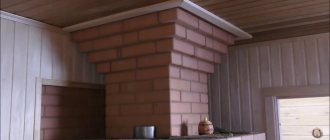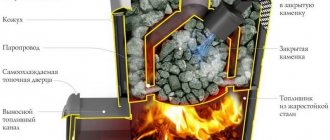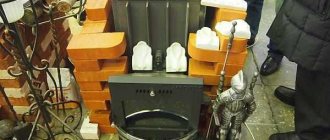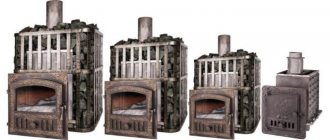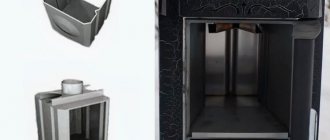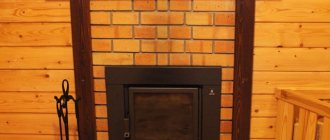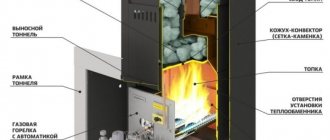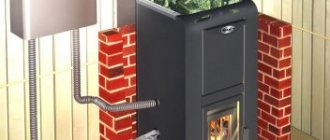The comfort, benefits and cost-effectiveness of bath procedures largely depend on the quality of the stove.
Therefore, the choice of a heating device intended for heating a bath should be treated with special care and responsibility. If you have any doubts regarding the selection of one or another model from a wide range of similar units, we suggest considering the functionality of the Troika stove.
With the help of this heating device in the steam room you can create a Finnish sauna mode . However, such a modern, domestically produced unit is best suited for creating a microclimate with moist, saturated steam, typical of Russian baths . A seemingly simple stove can produce excellent power, and to improve the external aesthetics of the device, you can make a spectacular brick cladding.
Strengths and weaknesses of the Troika stove
There are many positive aspects when using this device. Rapid heating of the unit is possible only in the summer; in winter, you will need to spend up to three hours of your time to properly heat the bathhouse. In order for the steam room to function all night, you will need a minimum of firewood. In addition, satisfied users claim that this inexpensive device is ready to work with a vengeance.
With all the advantages, the Troika stove also has certain disadvantages. Due to its rather heavy weight, which only four physically developed men can handle, problems arise with transporting the device. When making an inconspicuous-looking stove, manufacturers hoped that it could be decorated with brickwork.
For the person who purchased such a unit, there will still be additional costs associated with the purchase of material and hiring a specialist. In addition, having rather thick walls, the Troika stove slowly releases heat, which cannot be said about thinner-walled metal sauna devices.
Furnace lining
In addition to laying the foundation, direct installation of the stove structure and its connection to the chimney, installation work in most cases includes lining with refractory bricks.
At the first stage, a clay solution is prepared, which is used to make spherical samples, which are shaped into a cake and left to dry for 10 days. Samples are made in different ratios of clay and fine-grained sand, preferably mountain sand and carefully sifted from debris. The proportions are as follows:
- 1 sample: clay;
- 2 sample: 9 parts clay and 1 sand;
- 3 sample: sand and clay in a ratio of 1 to 3;
- 4 sample: 3 parts sand, 1 part clay.
Dried samples are tested for strength. To do this, each cake is raised 1 meter above a hard surface and released. An unbroken sample is the optimal mixing option for brickwork. The solution is mixed, filled with water and left for 3 days to impart the necessary elasticity.
You can also use a ready-made mixture, sold at any hardware store. The clay-sand composition is convenient to use, but it has a significant drawback - the ratio of components is not always stable. In this case, the composition is brought to the ideal level by adding pure clay (if the solution turns out to be “lean”) or sand (if the solution turns out to be greasy). To increase the strength of the masonry, you can add cement to the solution - 400 grams per bucket. The average consumption of the finished mixture is 1 bag per 80 bricks.
- Before starting work, the material is moistened with water. This will improve the quality of adhesion between clay and sand and brick.
- The solution is applied on top of the previous level.
- The first level of quality refractory bricks is made from whole bricks. They start from the far corner. At the next level, use ¾ of the block, subsequently observing this order. This makes it possible to connect the rows with the highest quality possible.
- During the finishing work, all additional furnace elements are installed.
- An opening necessary for further maintenance of the stove is left in the sash area.
- The masonry is carried out up to the upper level of the stove structure, but it is necessary to leave a small gap between the brick wall and the metal structure (8-10 cm). The gap is necessary for uniform heating of the brick screen and proper air circulation.
The stove is started after installing the chimney, starting at low temperatures for 20-30 minutes
Important! At the 2-3 level of masonry, it is necessary to leave several gaps of half a brick, necessary for ventilation and additional heating of the room.
Instructions for lining a sauna stove are presented in the video:
Design Features
As mentioned above, a distinctive feature of the device is the significant thickness of the side elements of the firebox. They are made from low alloy steel. The walls are 8 mm thick and the top is 10 mm thick. With such a robust firebox design, complete reliability and longevity of the stove are guaranteed. Due to the sufficient depth of the fuel channel in the dressing room, it is possible to build a remote firebox. In this case, the thickness of the walls of the steam room does not matter.
Another feature of the Troika sauna stove is the ability to lay a large number of stones (approximately 250 kg). In more standard designs, the mass of cobblestones ranges from 40 to 80 kg. Such a difference inevitably attracts the attention of people who are asking the price of various models capable of heating large areas of steam rooms.
The volume of the water tank depends on the features of a particular model. The convenient location of the container - on the front of the stove body - is acceptable for many owners of bathhouses where there is no running water. You can supply liquid to the tank using a bucket. In addition, this stove design is ideal for baths with low ceilings, where devices with a tank mounted on the chimney would look completely out of place. kindly provided the ability to easily remove the container for washing.
Performance characteristics
“Russian steam” in the steam room is provided due to the presence of a water supply receiving bowl in the lower section of the heater. The temperature in this section of the structure reaches 650 degrees, which allows you to get maximum wet steam with a minimum of effort on the part of the bathhouse attendant.
Important! If necessary, the stove operates in dry steam supply mode, which is typical not for baths, but for saunas. It is enough to learn how to control the convection flow.
The heater is located separately from the firebox. This means you won't have to regularly clean soot-covered stones.
Model range overview
To meet the needs of sauna and bathhouse owners, a wide range of Troika stoves is available. The main difference between the devices is the unequal volume of the water tank : for model 02, the liquid heating capabilities are expanded to 80 liters, while for stoves 01 and 05 the tank volume is limited - 72 liters. All devices have a front-facing container, which is very convenient for pouring liquid from a bucket. Owners of areas that do not have a water supply will appreciate this convenient design.
The large diameter of the pipe, which acts as a channel for smoke exit, eliminates the possibility of poor draft even in bad weather. With a special cleaning device located on the side of the structure, you can forget about the need to attract the help of a chimney cleaning specialist.
Cast iron doors of Troika stoves are particularly resistant to high temperatures. Standard size grates are also made of cast iron. Some models, in addition to a removable tank, are equipped with heat exchangers that help maintain heat in the wash room, rest room or dressing room.
Despite the fact that the body of Troika stoves has a special heat-resistant coating, which gives the device a modern look, greater aesthetics can still be added using brickwork. Manufacturers of such units deliberately produce models that later need to be lined with brick. Devices encased in soapstone tiles are also offered.
Thanks to the wide variety of reliable and high-quality Troika stoves, consumers can choose the most suitable option for them from the model range . Perhaps the compact model with the designation 07 will be just right for someone. Small dimensions (500x500 mm), the presence of a convector and a water tank with a capacity of 60 liters installed on the chimney are what is needed for small rooms with a standard ceiling height.
Adjustable convection ovens
Not everyone is happy with installing a brick screen. Therefore, the designers of Troika stoves have developed models that do not require the construction of screens. They are equipped with a specially designed casing and a temperature control system. After the steam room has reached the desired temperature, by turning the valve, all the heat is directed to heating the stones. In this way, a normal microclimate and well-heated stones are achieved.
This is the Troika 6RM1 model from different angles
The technical characteristics of Troika metal stoves with a closed heater are summarized in the table.
Technical characteristics of Troika ovens with adjustable convection (to increase the size of the table, right-click on the picture)
The large mass of stones and thermal inertia make it possible not only to maintain the temperature at the proper level for several hours, but also to dry the premises well after the steam room.
Installation features
Excellent heat transfer and long service life are just some of the trump cards that distinguish the Troika sauna stove from other analogues. The source of these advantages is the material of manufacture: cast iron or steel of reinforced thickness. In order for the stove to function normally and give off maximum heat, care should be taken to build a high-quality foundation and arrange a chimney.
The foundation is subject to requirements regarding its resistance to serious loads, because Troika stoves are considered quite heavy units. If we add here the weight of the brickwork, it becomes clear that this cannot be done without a super-strong foundation. The ideal option is to build a separate foundation for installing the stove during the construction of the bathhouse. In its absence, it is necessary to make a concrete slab reinforced with reinforcement. The thickness of the product will depend on the weight of the selected unit, but you should count on a range from 15 to 20 cm.
It is possible to ensure excellent draft throughout the entire service life of the stove using a chimney whose pipe has a cross-section of 150 mm. In this case, it is possible, and as practice shows, it is even necessary to use a sandwich pipe. To maintain a unified style, the chimney must be lined with brick.
Options for solving the problem
You need to do this to make the gases move along the box, and then return them to the existing channel.
If possible, you can try to make a separate channel for the heater. The firebox will go up through the grate along the box on both sides. There is a new channel above the box and a pipe on top. There will be a valve in the new channel, it needs to be closed, and the gases along the old path will be used to warm the stove and water, then open it and heat the stones. It is worth narrowing the firebox to increase the resistance of the old chimney. The new one should be more throughput. There is also an option to reduce the depth of the firebox by building a blank wall of refractory brick on edge. Behind the wall there will be a hole into the chamber of stones. The result is a convenient route: the front wall of the box - the top box - the back wall of this box - behind the new wall in the firebox - the chimney.
To begin with, you can try the following: you need to place the wall in the firebox as indicated above. While milking the sample, it doesn’t matter what kind of brick it will be. It is worth continuing this wall on the grates flat to the very top of the bricks so that there is at least one row of bricks between the wall and the ceiling. The main thing is that it does not fall into the new channel when the stones are laid. Then all that remains is to lay the stones and light the stove. If, after heating the furnace, the soot on the upper stones burns off and pure steam comes out when pressed, then you need to see whether it’s worth making a box or not. If everything is done as it should, then you can try attaching an 18 mm sheet to install the partition on the grates. It is not necessary to miss one yard from the arch - just make it higher than the stones. the main thing is the distance from the old to the new wall. The area of the new chimney must be at least 150 square centimeters. and also no more than the area of the main chimney. You can do more - but it will be pointless. There is no need to leave a hole in the stones: if the stones are larger than an orange, then they can be used. It is worth laying powder, because after heating they will shrink more, you can add a little more on top. You should not place stones above the middle of the door. This way there will be less risk of getting a jet of steam in your face when opening the door. If everything works out as it should, the stove will turn out very hot - approximately as hot as it should be with no direct movement. This means that when you start lighting, a lot of soot will fall onto the stones. As it warms up, the soot should burn out well. You can steam in such conditions only when the stove has completely finished heating. There should be no coals in the chamber. If the door with stones is single, then after stopping the fire, but before steaming, the steam room should be well ventilated.
In a good way, it’s worth extending the fireclay firebox to the heater. This is possible because the volume is very large: 150 kg of stones will occupy only half of the heater chamber. It is worth installing a damper or a second door in front of the door to the stones in the steam room. If you make the stove run straight, this can make it easier to start a cold stove, add a few more degrees to the stones, but also increase the heating time. It turns out that first, through the stones, after drying the pipe, it is worth warming the water, and after warming up the stove, warm the stones. Not after heating the water, but rather the stove. Otherwise, when heating the stones, you can get a large uneven heating of the furnace, and it will begin to crack like a ladder diagonally from the pipe to the grate of the stones.
You can also install a damper in the chimney with a top opening, located on the inside of the stone chamber. that is, they were carrying to look from the cell, then first there is a shutter, and then the door. When vaping, you just need to take it out. But all the alterations can also turn negatively, and more and more new problems will appear.
Gas sauna stoves
Bath Troika is also available on gas. One model - 07-GT20 - with an open heater is suitable for saunas, all others - with a closed one, for baths and saunas. They are made of the same steel, the wall thickness in unloaded areas is 10 mm, in loaded areas - 20 mm. The exception is the Troika 07-GT20 model. This is an option for a sauna, so the metal (steel 09G2S) is thinner (5 mm and 10 mm) and there are relatively few stones - 60 kg.
The technical characteristics of stoves with gas burners are summarized in the table.
Technical characteristics of Troika stoves with a gas burner (to increase the size of the table, right-click on the picture)
The 5r-GT60 model has two heaters, which can be used alternately, always receiving very hot and light steam. This model can also heat a dressing room (rest room) using convective flows controlled by a damper. All units except the first are equipped with gas burners that automatically maintain the set temperature. All these models are modifications of wood stoves. All of them require the construction of a brick screen to absorb harsh thermal radiation.
All gas stoves for baths can be equipped with a heat exchanger and a remote tank with a capacity of up to 100 liters.
